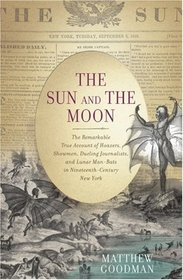The book covers the background and response to the Great Moon Hoax of 1835, in which the New York Sun published a fictional account of using a telescope to observe life on the Moon. This was one of the first mass media frenzies, and it is certainly important to examine. In some respects, the book does a good job of it, going into the backgrounds of not only the principle characters involved, but also what New York was like at the time, the political environment (especially abolitionism), the newspaper business in the United States up to that point, the common beliefs which played a role in the wide acceptance of the hoax, and the reactions to the hoax.
The book's problems come from how it handles the more tangential material. The author spends a lot of time on P. T. Barnum and the exhibition of Joice Heth, even though this did not play a direct role in the hoax. Edgar Allan Poe, whose own attempted hoax may have inspired the Great Moon Hoax, should have been mentioned earlier in the narrative and feels somewhat awkwardly stuck on where he was. The real John Herschel, whose imaginary exploits were described in the hoax, was not given nearly enough coverage. While the material directly around the Moon Hoax was generally very good, the more tangential material was not well tied into it, with the result that it felt like padding to get the book up to a specific length. The texts of the original Moon Hoax itself was not included, which might have been interesting to read, nor were the additions of others, even though some of this was mentioned in the text. A slimmed-down version of this book with a change in emphasis might have gotten four or five stars, but as it stands I can only give it three. Still, this is well work reading for anyone curious about the Great Moon Hoax and its times.
The book's problems come from how it handles the more tangential material. The author spends a lot of time on P. T. Barnum and the exhibition of Joice Heth, even though this did not play a direct role in the hoax. Edgar Allan Poe, whose own attempted hoax may have inspired the Great Moon Hoax, should have been mentioned earlier in the narrative and feels somewhat awkwardly stuck on where he was. The real John Herschel, whose imaginary exploits were described in the hoax, was not given nearly enough coverage. While the material directly around the Moon Hoax was generally very good, the more tangential material was not well tied into it, with the result that it felt like padding to get the book up to a specific length. The texts of the original Moon Hoax itself was not included, which might have been interesting to read, nor were the additions of others, even though some of this was mentioned in the text. A slimmed-down version of this book with a change in emphasis might have gotten four or five stars, but as it stands I can only give it three. Still, this is well work reading for anyone curious about the Great Moon Hoax and its times.




